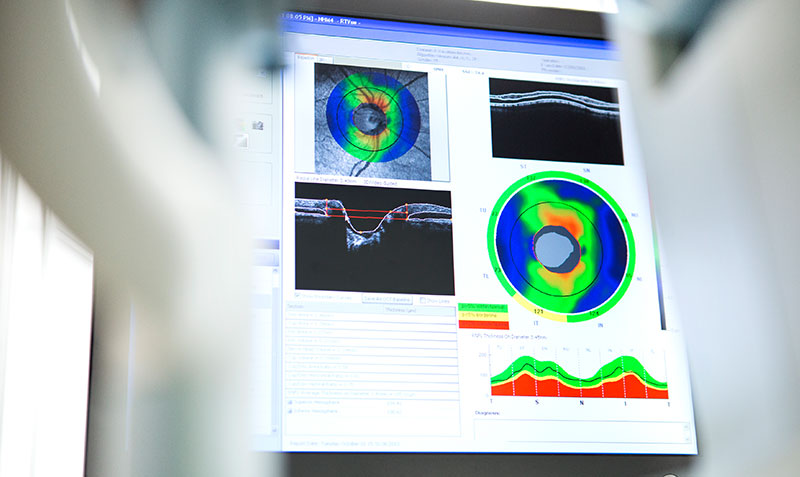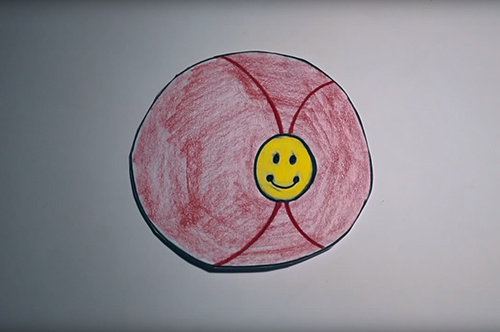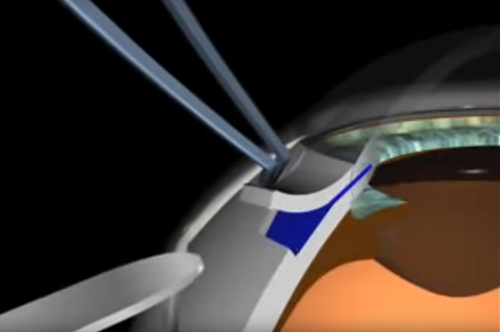Glaucoma is an eye condition charactarised by loss of vision due to damage of the optic nerve and gradual loss of the visual field. Usually, but not always, glaucoma is accompanied by an increase in intra-ocular pressure. The reasons for this elevated inner eye pressure are various, but the result is the same: it damages the optic nerve and therefore your eye sight.
Diseases
Glaucoma
Glaucoma

What is glaucoma?
Glaucoma is an eye condition charactarised by loss of vision due to damage of the optic nerve and gradual loss of the visual field. Usually, but not always, glaucoma is accompanied by an increase in intraocular pressure. The reasons for this elevated inner eye pressure are various, but the result is the same: it damages the optic nerve and therefore your eye sight.
Glaucoma is one of the most common causes of blindness, nevertheless eye sight can be saved if diagnosis and treatment are started during the early stages of the disease. The eye recieves nourishment from a clear fluid that circulates inside the eye, called aqueous humor. Aqueous leaves the eye through a sponge-like tissue called trabecular meshwork. If this canal is obstructed, the inner eye pressure rises. It is this persistant increase in intraocular pressure that will damage the delicate fibers of the optic nerve which connects the eye to the brain. As a result, vision is lost gradually. In general, this type of glaucoma is painless and deterioration of the visual field is usually only detected once it reaches the centre of vision.
The ophthalmologist can detect this disease at an early stage through different types of examinations. The optic nerve at the back of the eye is examined and intraocular pressure is measured. If in doubt, a computerised visual field test may detect early stages of visual field loss.
How many people suffer from glaucoma?
Glaucoma is a widespread disease. The likelehood of developing glaucoma increases with age. Including preliminary stages of the disease, 2.4% of the population above the age of 40 suffer from glaucoma. Past the age of 75, the frequency of the disease rises up to 7% – 8% of the population. Therefore, age is the number one risk factor for developing glaucoma.
Other risk factors are a family history of glaucoma within first-grade relatives, high myopia (shortsightedness above 5dpts) and afro-caribbean background. Also, special drugs have an influence on your eye pressure. If you need to take steroid drugs for rheumatism or allergies over a prolonged period of time, you are more likely to develop glaucoma. This is not only true for oral steroids and steroid eye drops, but also for other steroid applications such as nose drops. If you suffer from diabetes or vascular diseases, you are at higher risk of developing glaucoma.
Are there different types of glaucoma?
The most common form of glaucoma is called open-angle glaucoma or glaucoma simplex. It is charactarised by a gradual obstruction of the trabecular meshwork causing the inner eye pressure to rise. In the early stages, a person will not experience any symptoms. The resulting damage of the optic nerve is only detected if larger parts of the optic nerve are destroyed and parts of the visual field are lost. There are no outer signs for the patients to detect glaucoma. It is not possible to measure eye pressure by palpation.
Open-angle glaucoma is especially dangerous because it stays undetected by the patient for years, while the disease destroys vision gradually. The ophthalmologist can detect the disease at an early stage using different diagnostical measures and design suitable therapy to attempt to preserve vision.
In contrast to the gradual progression of open-angle glaucoma, the more rare type of the angle-closure glaucoma (acute glaucoma) shows symptoms which will induce the patient to seek medical advice instantly. Due to the sudden obstruction of drainage, intraocular pressure rises significantly, causing severe pain in or around the eye. The eye becomes red and painful, often there is mistiness of vision and episodes of seeing halos around lights. The danger of loosing eyesight is very high, but vision can be saved if treated by an eye specialist in time.
Early detection of glaucoma is the first step towards preservation of vision!
If you belong to a group with higher risk for developing glaucoma, you should have regular check-ups with your ophthalmologist. The ophthalmologist will examine your optic nerve and together with the intraocular pressure will calculate the risk of having or developing glaucoma. He will then be able to advise whether:
- Your eyes are healthy. Follow-up should be performed in yearly intervals.
- Your eyes look healthy at the moment, but to provide security additional diagnostic measures need to be taken. More frequent follow-ups may be advised.
- An undetected glaucoma or an early stage of the disease are diagnosed. Regular follow-ups and treatment are necessary.
Treatment of the various types of glaucoma
The most common form of glaucoma, called open-angle glaucoma, is mainly treated with drug therapy. The aim of treatment is to lower intra-ocular pressure to prevent further visual field loss. The first form of treatment is usually eyedrops, which have to be applied 1-2 times daily. Applying drops properly and as prescribed is essential. Regular follow-ups with an ophthalmologist, who will check the efficacy of the eyedrop therapy, are essential.
- Reaching better control of your blood pressure and your heart condition together with your GP or internal medicine specialist will protect your vision additionally.
- Only in those cases, where drug therapy does not lead to the desired success, surgery or laser surgery should be considered..
- In the case of acute glaucoma, the eye pressure is first reduced using drugs. After that, surgery is performed to restore the equilibrium between the production of aqueous and its drainage.
.
The prognosis for your vision
Glaucoma is one of the most common reasons for blindness, because the disease is diagnosed too late. Glaucoma can only be controlled, but not cured. Therefore, only further visual loss can be prevented. The earlier the onset of therapy, the better the prognosis.
During glaucoma treatment, patient compliance concerning the application of the prescribed eyedrops are as essential as regular follow-ups by an ophthalmologist. Therefore, don’t hesitate to book an appointment for a thorough eye examination with Prof. Findl!


